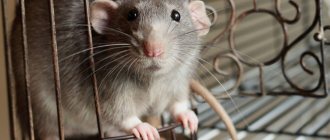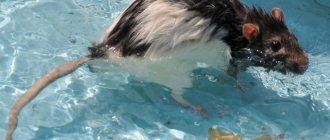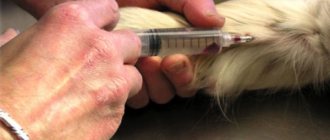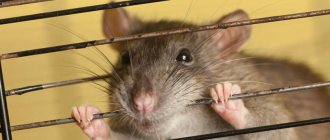Training of decorative rats at home. Where to start training a rodent. What needs to be done to make training easy and useful. What not to do during training. Rules of training, features of training.
We all know that rats are very smart animals that respond to their name and learn quickly. We want to have not just a pet, but also a faithful friend who is easy to get along with, understands his owner perfectly and can surprise with tricks.
Next, we will look in detail at how to train a rat, where to start training, features of training and what mistakes should not be made.
What is the best way to encourage an animal?
First of all, you need to understand that when training, the owner must be patient and speak only in a quiet and gentle voice. Rats are quite timid, and if you yell at them, they will get scared, which will greatly complicate the situation, since they will associate training with unpleasant and scary emotions.
Any effort should be rewarded. Therefore, when training, it is necessary to give the animal treats. If he performs actions, be sure to reinforce this with a tasty treat, this way the animal will build a chain of when and for what he can get a treat.
As for which treats are best suited, everything is individual, it all depends on the pet’s taste preferences. You can give boiled rice, pumpkin or sunflower seeds, only peeled, walnuts, boiled chicken, etc. Remember that cheese is a prohibited product for the animal because it is a fatty product.
Necessary commands to control a dog in the city
Constantly in contact with social society, it is necessary to be confident in the dog’s skills, especially for owners of “potentially dangerous breeds”. At the moment there is a special canine course called UGS (controlled city dog), it is often confused with OKD (general training course), but these are two completely different standards. Training in the UGS course is divided into two stages - at the training site and in the city.
First stage (on site):
- Moving next to the handler on a leash;
- Movement nearby by a trainer without equipment;
- Landing the dog from movement;
- Styling the pet with restraint and recall;
- Styling in the presence of distractions.
Second stage (in the city):
- Meeting a dog with people;
- Meeting the bike;
- Animal's reaction to a car;
- Behavior when meeting runners (roller skaters);
- Actions when seeing other dogs;
- The reaction of a pet left on a leash towards others.
The main part of the skills is related to the socialization of the animal, which suggests that social adaptation in the city is even more important than following commands.
Where should you start?
The first thing to consider is the age of the animal. Remember that animals that are too old are not suitable for training, just like animals that are too small. An elderly rat will be exposed to a lot of stress during such lessons, which is extremely undesirable at this age.
Small animals cannot fully perceive information; they are active, very mobile and playful. The ideal time for training is from 2 months to 2 years.
There is no need to start training with difficult tricks; it would be correct to start with very simple tasks. For example, standing on your hind legs is suitable, and simple tricks include turning around yourself.
No matter what starting trick you choose, be sure to be patient. And remember, you cannot overload the animal, it should bring joy and evoke pleasant emotions. Classes should last no more than half an hour per day.
So, first of all, you need to remember that a rat has its own character and mood. Sometimes her mood is not in the mood for learning, she wants to sleep or be alone, you shouldn’t force her, you need to find another time.
If the animal is in a good mood, we let it smell the treats and treat it with a small piece. Next, we begin to “lead” her for a tasty treat, for example, we lift her up so that she stands on her hind legs or turns around, and after completing the task we give a reward, and be sure to praise her.
Age features of training
At different ages, puppies, like children, go through certain periods of growing up. When training, it is necessary to take into account age characteristics and give the child a load that he can handle.
1 month
At the age of 1 to 2 months, each puppy goes through the formation stage. During this period, babies actively communicate with their mother, their brothers and sisters and people. They remember everything new very quickly, and it is at this stage that they become more independent.
At this age, babies need constant communication. Any mistakes in parenting, even minor ones, can lead to serious behavioral problems in the future.
2-3 months
At the age of 2-3 months, the pet enters the socialization phase. During this period, the animal learns to live in society, and it is this time that is considered the best for establishing proper contact and mutual understanding between the dog and the owner.
Most puppies at this age are already in a new home, so the owner must take on the responsibilities of the bitch and explain to the baby what can and cannot be done. At this stage, the small pet begins to be taught the commands “Come”, “Fu”, “Sit”, “Lie down”.
4-6 months
At 4-6 months, the puppy actively walks and communicates with strangers and animals. At this age, the pet can try to win a higher place in the hierarchy, but it has not yet encroached on the place of the leader.
At this stage, the puppy is taught the commands “Come to me”, “Place”, “Walk”, a set of three commands (“Sit”, “Lie down”, “Stand”), “Fetch”, “Nearby”. The pet is also introduced to booms, stairs, and low barriers.
Clicker training
Earlier we talked about the fact that when a rat completes a given task, it not only needs to be treated with a treat and rewarded with a kind word. But we need to remember that they do not perceive vowel sounds well, so we use words with a lot of consonant hissing sounds or turn to a clicker for help.
This is a small device that makes a click when you press a button. When choosing such a device, you should give preference to those that produce a muffled sound; in the apartment they are amplified and it is very important not to scare the animal.
The mechanism for using a clicker is quite simple; it allows the rat to correctly navigate its actions. It must be used every time the animal performs a trick correctly; we can say that it replaces the owner’s praise.
But remember that it must be used correctly, namely, there must be a clear sequence. If you use it after a trick, but before giving it a treat, the click will be associated with the reward.
You can buy such a device at pet stores, but before using it you need to make sure that the sound is not loud and will not scare the rat. The clicker can be easily replaced by clicking your fingers, the result will be the same, and you can also click your tongue.
Bathing
The decorative white rat is an intelligent and clean creature that spends a lot of time cleaning its fur. But sometimes these pets still need additional help from their owners in bathing. Many rodents do not like water treatments. Albinos are afraid of water and can experience stress when in contact with it, which is why it is worth teaching the animal to bathe from a very early age. If the cage is cleaned constantly, then you won’t have to bathe the animal often.
There are people who argue that bathing rats at home is prohibited. But there is another opinion, which indicates the permissibility of infrequent water procedures if all safety conditions are met during the process.
It is necessary to bathe white rats in the following situations:
- if the animal is stained with a harmful substance;
- when staying in a dirty cage for a long period;
- if a rat does not clean its own fur, that is, it is sick or unkempt;
- when removing parasites;
- several days before the exhibition.
When a domestic rodent does not like water, there is no need to bathe it unless absolutely necessary. If the animal is not too dirty, then you can wash it without using shampoo. During the procedure, it is worth talking to the rat to rid it of fear. It is necessary to refuse bathing if the animal has a cold, as washing can aggravate the disease.
The rat prefers to live in a clean environment; it does not shit where it eats and sleeps, so installing a toilet in the rodent’s cage will not be superfluous. Accordingly, if there are no unnecessary odors and debris in the house, the animal can be bathed less often.
When bathing a white rat, do not forget about such points as:
- decorative rodents are prone to diseases of the ENT organs, so keeping the animal in a draft after bathing will lead to illness;
- cold indoors, cool water, or undried rat fur can worsen the health of the animal;
- if water gets into the ears of an ornamental pet, otitis media and deafness may occur;
- the use of detergents can cause changes in the natural odor of the animal, disruption of the barrier function of its skin, and cause dryness and scabies.
It is better to buy a special product for bathing rodents, but if you don’t have one, then you should use shampoo for cats. According to experts, you can use baby detergent to bathe your rat, but it should not contain dyes or fragrances. For the procedure of washing a rodent, it is worth preparing several containers with warm water, shampoo, a towel and a piece of soft cloth that will replace a washcloth. Rats should not be washed under running water; before bathing, their ear canals should be covered.
Immersion of the animal in a container with liquid should be done slowly and carefully, while stroking it and distracting it with conversation. The fur should be carefully moistened with water, and then shampoo should be applied with massaging movements. The detergent should be rinsed off in two containers of water, and then dried with a towel or cloth.
The rat's tail should also be washed, as dirt and dead skin particles accumulate on it. The organ should be moistened with a cotton pad that has been previously soaked in a soap solution. After this, the tail is cleaned with a toothbrush, but gently and without pressing. Next, the organ is washed off with warm water, wiped and lubricated with odorless baby cream.
Accustoming to a name
The most important trick with which a pet’s training often begins. It is recommended not to give the animal long names, even if it is very beautiful, since the rodent will not appreciate it anyway, but it will be much more difficult for him to remember it and navigate when playing it.
The name should be short, and also have hissing sounds, to which the rodent reacts. Training occurs as follows: you need to take a treat and, holding it in your hand, call it by name at a short distance from the rat.
When the animal runs up and eats the treat, pick it up, praise it and let it go. After the rat has received the treat, the training ends; it should last no more than 20 minutes. Before training, you need to clearly define the name and not change it during training, since this will only lead to the animal being knocked down.
A little history
Cute, affectionate and tame decorative rats are descended from ordinary wild gray rats, which cause a feeling of disgust in humans, as well as a certain fear. This is not at all surprising, since wild rats have gained notoriety not only for their behavior, but also for their ability to spread various viruses and infections.
The Chinese and Indians first became aware of wild rats several thousand years ago. In the 16th century, as maritime trade developed, rats spread throughout the world, moving from continent to continent. In the 19th century in England, these rodents began to be used in battles against dogs, after catching them. During the same period, some hobbyists began breeding rats, especially tame, white ones. Such tame rodents were shown at exhibitions; in addition, white rats took part in circus performances. Some pet lovers started keeping rodents in their homes because they did not pose any danger to humans.
Some of the individuals were used as experimental animals in various laboratories, which is still practiced today, and some of them moved into the homes of scientists. Scientists saw in rats animals that are quite intelligent and attached to humans. Thanks to the crossing of laboratory rats with wild animals, new species and breeds of domestic decorative rodents have appeared, which can still be found among various breeders.
Team requirements
There is nothing complicated about them, the main thing is to do everything correctly. The command should be short and clear; in other words, you shouldn’t say whole sentences to the rat, it won’t understand them anyway.
When training, a clicker, sound stimulators are used, and you can also use certain gestures. These gestures should be performed with your free hand, not the one holding the treat. Also remember that the gesture should be clear, short and uncomplicated.
Do not overload your pet; training should be an interesting, fun and exciting experience for him. The lesson should not last more than 30 minutes; during this period the rat will not get tired and will be able to learn new things.
Is it easy to train rats?
Rodents constantly communicate with each other, sharing information about where food is in the house, how to get there and how to get a tasty morsel. At the genetic level, they have a desire to build logical chains to achieve the desired goal. Otherwise, the animals simply would not survive. Therefore, if you understand the animals and direct their energy in the right direction, you can teach them tricks and commands.
Is it possible to train to a tray?
If you train your pet to use the tray, the task of cleaning the cage will be much easier. The principle of training to the tray is the same as in previous cases. You should set a task, show patience and create all the conditions for the animal to complete it.
So, we put a tray in the cage, put the filler there, as well as the excrement of the rodent, only him, no other rodents, this will only push the animal away from it and scare it.
If you see that a rodent is going to the toilet on the tray, be sure to praise it and treat it with treats. If the rat goes to the toilet on the floor of the cage, try to distract it, but under no circumstances shout or make sudden movements.
Over time, the animal will understand why the tray is there; in addition, they are very clean, so they will be happy to go to one place.
Method of taming a rodent
Taming a hamster requires patience, attention and systematicity.
It is important to learn to understand your pet’s signals and earn his trust. If you rush, you will get a rodent that bites and runs away because it is afraid of you
As long as the baby is afraid of you, you will not be able to make friends with him. Follow the procedure described below and before moving on to the next step, make sure that the pet has not received stress in the current step.
Give your baby the opportunity to get comfortable in the cage, watch how he eats, drinks, and plays in your presence. Talk to your baby near the cage in a calm voice. Don't know what to say? Sing a song or tell us about your day. Place a seed on your palm (be sure to read which seeds can be given to a hamster) or a piece of cookies or dried fruit. Offer treats through the bars or cage door first. If he shows interest, stick your hand into the cage, but do not touch the hamster. If he runs away, you should never catch him so that he can smell the treats. Just place them in your palm and wait. Don't stop offering your baby treats, but you still shouldn't pet the hamster. Position your palm so that your baby puts his paws on your hand and reaches for the treat. Place the seed so that the baby can take it only after he climbs onto your hand. After he boldly does this, try to carefully pick up the hamster in your arms. Most likely the baby will jump right away, but be persistent and careful. Over time, the baby will realize that your hands do not pose a danger to him.
You already know how to accustom a dwarf to your hands, but how long will it take? It all depends on the individual characteristics and age of the animal. He can get used to the hands of an adult in a few days, but sometimes it takes about a month.
According to the scheme given above, you can tame the Djungarian and the Syrian. You just need to take into account that the Djungarian hamster loves to bite. Representatives of the Syrian breed are calmer.
You already know how to tame a Djungarian hamster, so that this happens easier and faster, consider a few points. Before picking up the baby, you need to wash your hands with soap, because the animals’ sense of smell is better developed than their eyesight. If your palms smell like food, your hamster may bite.
Training rules
It is very important to be patient while training. You cannot use sounds that are not related to training, so as not to confuse the animal. Remember that there should be no punishment, the animal tries very hard and wants to do everything right, but cannot always understand the task, you need to help him and reward all his efforts.
You shouldn’t rush things and try to skip step-by-step lessons, for example, you want to teach a rodent to climb a rope, for this you need to go through a lot of lessons, you can’t just hang a rat on a rope in the hope that it will understand everything and climb it.
Repeat the material you have covered, as new lessons will be remembered, and old ones will be forgotten over time. Combine all training with games to make the animal interesting and fun.
Water attraction for pets
In the summer heat, you can arrange fun entertainment for decorative rats by inviting them to splash in a pool with peas. A wide metal basin, deep bowl or plastic tray with a convex bottom will work as a pool. The selected container is filled with warm water and frozen green peas (or corn kernels, if rats like them) are thrown into it.
Catching peas from the water will not only be a fun game for rodents, but will also help them cool down on a hot day. And to make this activity more exciting for them, you can lean ladders against the outer sides of the makeshift pool, along which the animals will climb to the water.
Care
Caring for an unpretentious animal is not difficult, you just need to follow the rules of hygiene and feeding. However, these things should be taken seriously. Rodents, especially decorative ones, are susceptible to various kinds of diseases. Their diet should be balanced and the food fresh.
What to feed
Due to its physical characteristics, the rat is an omnivore: it happily eats meat and vegetable dishes, cereals and porridges.
To maintain the balance of minerals and vitamins in feeding, you need both boiled porridge and raw cereals:
- buckwheat;
- corn;
- rice;
- wheat;
- barley.
You cannot feed the following foods:
- chocolate;
- raw vegetables - cabbage, potatoes, spinach;
- sweets;
- spicy, salty, smoked, fried;
- alcohol;
- soda.
Important! There is no need to worry about the amount of food - rodents have a developed sense of fullness, and they never eat more than they need.
Hygiene and bathing
Proper care that will ensure a long and healthy life for your pet includes a clean home.
The cage requires daily cleaning:
- washing dishes;
- changing water (it should always be fresh);
- replacing the filler and cleaning the tray.
Video: bathing rats
Possible diseases and their prevention
Domestic rodents do not come into contact with street animals that can carry infections and bacteria. Typically, tame animals have a well-developed immune system, so health problems can only be hereditary, or acquired as a result of errors in care.
Important! Each genotype has its own predisposition - for example, megacolon (an abnormality of the large intestine) is hereditary in Blazes.
Factors provoking diseases:
- improper diet;
- poor quality products;
- lack of hygiene (personal and indoor);
- drafts, cold or heat, high humidity.
These errors in caring for your pet can cause the following diseases:
- Teaser's disease (an acute infection characteristic of rodents);
- pseudotuberculosis;
- pneumonia;
- pituitary tumor;
- tail necrosis;
- pneumococcosis.
Also read about why your pet rat itches.
Among the preventive measures:
- purchasing an animal from trusted breeders;
- a well-designed diet that excludes prohibited foods;
- kept in a dry, moderately warm place, without drafts;
- exclusion of stressful situations.
At the first examination, you can get competent advice from a rodentologist on the conditions of keeping the rodent. Vaccination will help eliminate health problems. The specialist will select a vaccine against diseases needed according to the animal’s belonging to a particular species.
How to train and play with your pet
It is not difficult to train a rat: from the first days of communication, it recognizes its owner and willingly makes contact. Playing with a candy wrapper on a string or climbing a rope - in general, everything that requires movement gives her pleasure. During such fun, the rodent learns to trust the owner and remembers repeated gestures or sounds.
Video: how to train a rat
A smart baby quickly remembers his name and responds to it. The animal easily masters commands: bring an object, jump over an obstacle and many other tricks. The main thing is to focus on a certain action, for example, then give out a treat.
Did you know? During research, scientists from the Chinese University of Hong Kong discovered a gene in rats that protects the body from sexually transmitted diseases.











